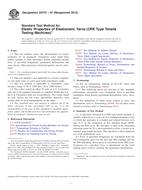Potrebujeme váš súhlas na využitie jednotlivých dát, aby sa vám okrem iného mohli ukazovať informácie týkajúce sa vašich záujmov. Súhlas udelíte kliknutím na tlačidlo „OK“.
ASTM D2731-07(2012)
Standard Test Method for Elastic Properties of Elastomeric Yarns (CRE Type Tensile Testing Machines)
Automaticky preložený názov:
Štandardná skúšobná metóda pre elastických vlastností elastomerných priadzí ( CRE typ skúšky ťahom stroje )
NORMA vydaná dňa 1.7.2012
Informácie o norme:
Označenie normy: ASTM D2731-07(2012)
Poznámka: NEPLATNÁ
Dátum vydania normy: 1.7.2012
Kód tovaru: NS-21335
Počet strán: 5
Približná hmotnosť: 15 g (0.03 libier)
Krajina: Americká technická norma
Kategória: Technické normy ASTM
Anotácia textu normy ASTM D2731-07(2012) :
Keywords:
elastic properties, elastomeric yarn, force at specified elongation, permanent deformation, stress decay, ICS Number Code 59.080.20 (Yarns)
Doplňujúce informácie
| Significance and Use | ||||||||||||||||||||
|
This test method is considered satisfactory for acceptance testing of commercial shipments since current estimates of between-laboratory precision are acceptable and the method is used extensively in the trade for acceptance testing. If there are differences of practical significance between reported test results for two laboratories (or more), comparative tests should be performed to determine if there is a statistical bias between them, using competent statistical assistance. As a minimum, use samples for such comparative tests that are as homogeneous as possible, drawn from the same lot of material as the samples that resulted in disparate results during initial testing, and randomly assigned in equal numbers to each laboratory. The test results from the laboratories involved should be compared using a statistical test for unpaired data, at a probability level chosen prior to the testing series. If bias is found, either its cause must be found and corrected, or future test results for that material must be adjusted in consideration of the known bias. Force at Specified Elongation (FASE) is a measure of the tensile force required to extend a textile material within specified limits. This characteristic of elastomeric yarn indicates the resistance that will have to be overcome by the wearer while putting on a garment made of the material and is also an indication of the garment's resistance to deformation caused by normal body movements during wear. The elongations used for these measurements are typically 100 %, 200 % and 300 %. Permanent Deformation (set) is a measure of the increase in length of an elastomeric yarn resulting from cyclic stretching and relaxation. The characteristic is a visible indication of the realignment of intermolecular bonds within the elastic material. As with stress decay, the amount of set increases with yarn extension; however, for any particular extension, little or no additional set takes place after five cycles of exercising. Generally, the characteristic set of the yarn is developed during fabric preparation and the fabric itself shows a negligible amount of set. Stress decay increases with yarn extension, but at any specified extension the stress decay takes place in the first 30 s with insignificant decay after 5 min. This characteristic is caused by the gradual realignment of intermolecular bonds within the elastic material, and helps to explain the changes in yarn properties that accompany cyclic stretching and relaxing. The realignment of the bonds is a reversible effect. Following complete relaxation of the yarn, the molecules tend to assume their original configuration with just about complete elimination of the previously observed strain. This test method was developed using elastomeric yarns in the “as-produced” condition, but may be used for treated elastomeric yarns provided the treatment is specified. The method does not cover the removal of finish for the determination of elastic properties of “finish-free” elastomeric yarns. |
||||||||||||||||||||
| 1. Scope | ||||||||||||||||||||
|
1.1 This test method covers the determination of elastic properties of “as produced” elastomeric yarns made from rubber, spandex or other elastomers. Elastic properties include force at specified elongations, permanent deformation and stress decay. Other hysteresis related properties can be calculated. Note 1—For a method designed specifically for testing rubber threads, refer to Test Method D2433. 1.2 This test method is not applicable to covered, wrapped, or core-spun yarns or yarns spun from elastomeric staple. 1.3 This test method is applicable to elastomeric yarns having a range of 40 to 3200 dtex (36 to 2900 denier). 1.4 The values stated in either SI units or U.S. Customary units are to be regarded separately as standard. Within the text, the U.S. Customary units are in parentheses. The values stated in each system are not exact equivalents; therefore, each system shall be used independently of the other. 1.5 This standard does not purport to address all of the safety concerns, if any, associated with its use. It is the responsibility of the user of this standard to establish appropriate safety and health practices and determine the applicability of regulatory limitations prior to use. |
||||||||||||||||||||
| 2. Referenced Documents | ||||||||||||||||||||
|
Odporúčame:
Aktualizácia technických noriem
Chcete mať istotu, že používate len platné technické normy?
Ponúkame Vám riešenie, ktoré Vám zaistí mesačný prehľad o aktuálnosti noriem, ktoré používate.
Chcete vedieť viac informácií ? Pozrite sa na túto stránku.




 Cookies
Cookies
